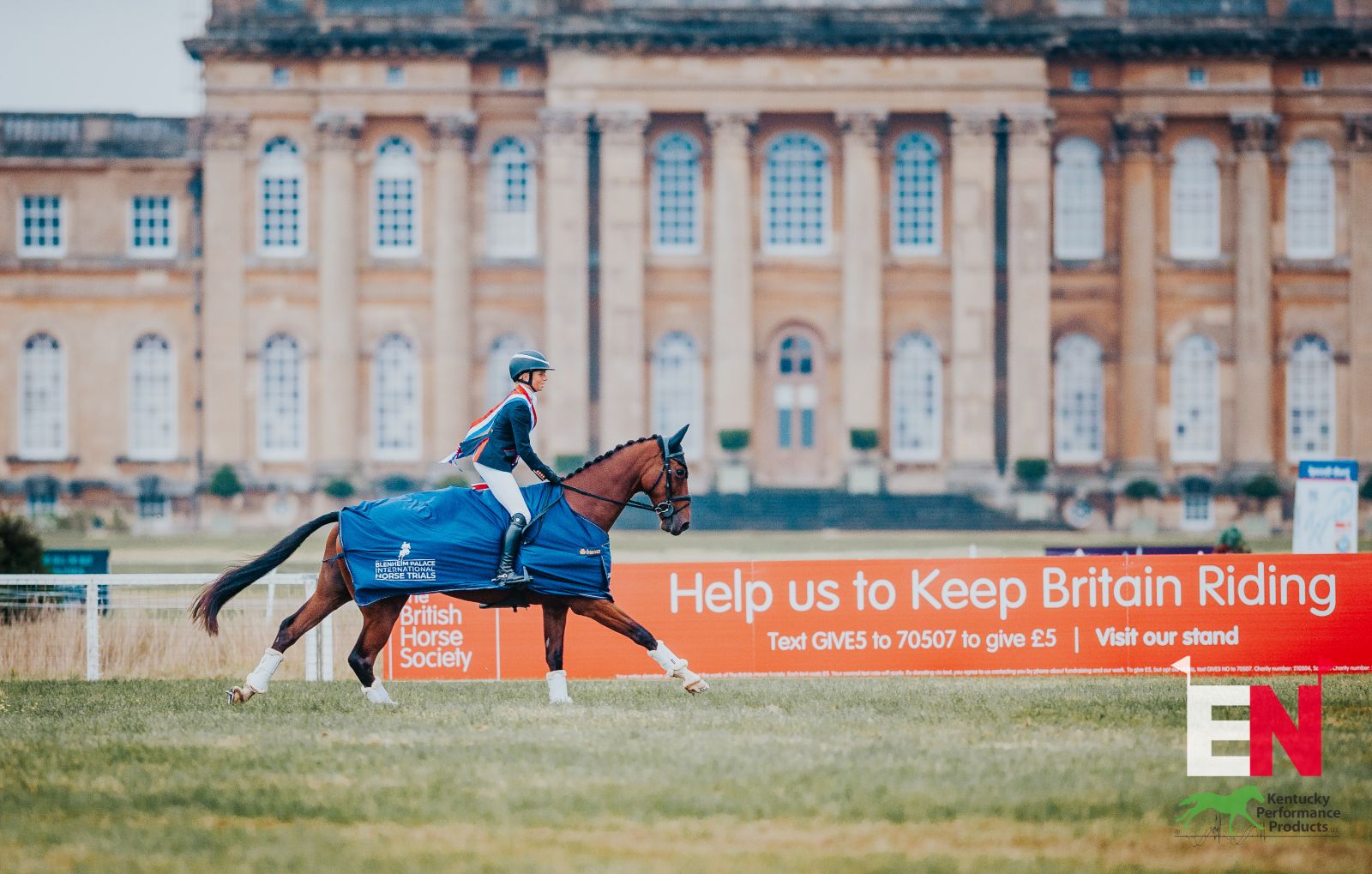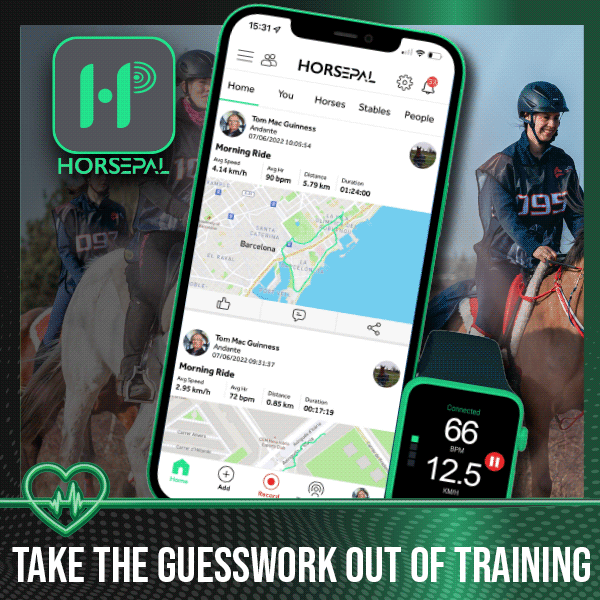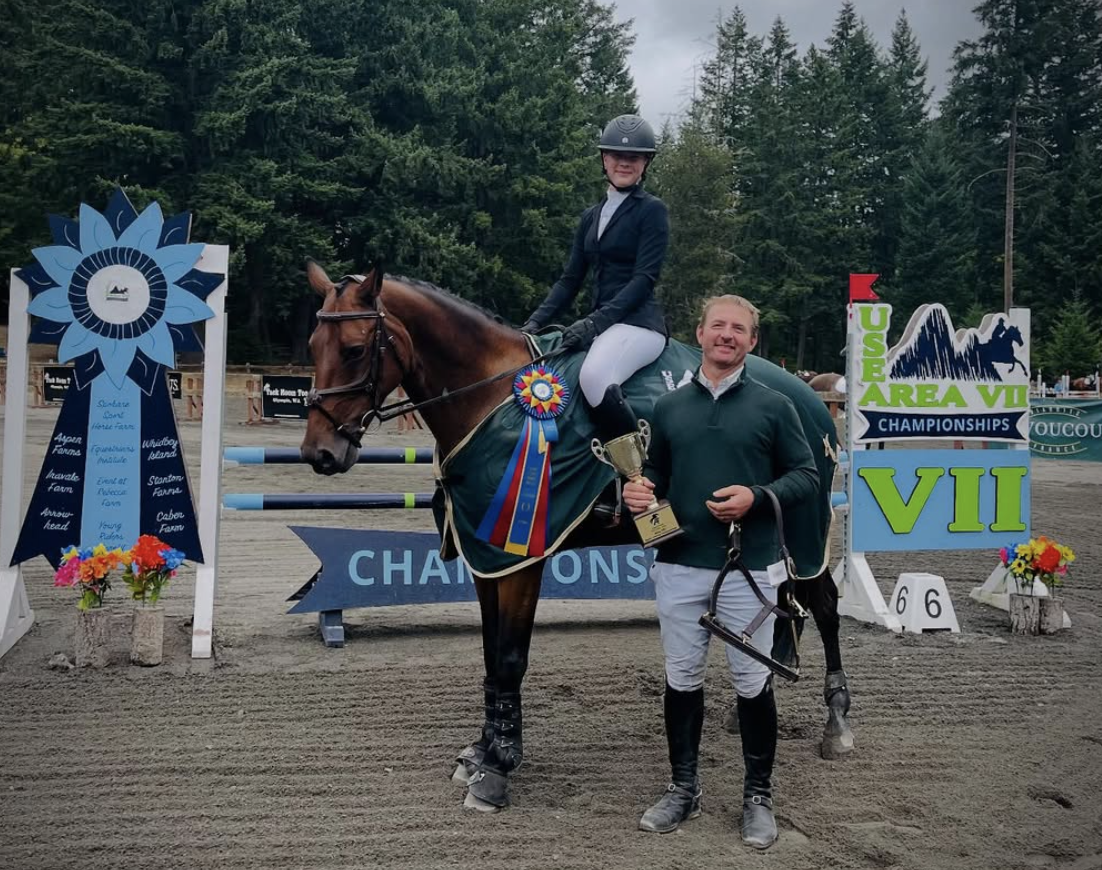Ros Canter and Izilot DHI take Blenheim’s CCI4*-L in 2023 – in front of a part of the Palace that’ll be under wraps this week. Photo by Tilly Berendt.
The week of the 2025 Agria FEI Eventing European Championships is upon us, and over the next 24 hours or so, some of the greatest horses and riders from across our broad continent will descend upon the parkland of the Blenheim Palace estate, ready to begin their fight for a podium space.
Blenheim, which is located just a handful of miles northwest of dark academia paradise Oxford, is one of Britain’s most palatial houses: the birthplace of Winston Churchill was built in the 18th century as a symbol of the empire (RIP hun xoxo) and boasts some 12,500 acres of parkland, designed by Capability Brown. Yes, that’s the very same landscape architect responsible for the grounds at Badminton and Burghley – the latter even, famously, has a road crossing on course named after him at Capability’s Cutting.
It’s the capacious parkland that’ll be the focal point of this week’s competition, because there’s an elephant in this ballroom that we need to evict nice and early: the Palace is covered in scaffolding. Though the main arena and part of the cross-country course is overlooked by the southern façade of the Palace, with its columned entrance, it won’t be the background we’re used to seeing. Instead, the middle section of the façade – the columns, the entrance, the main bit, really – is hidden behind the protective plastic sheeting that covers the scaffolding, and it will neither be removed nor covered over with an image of the palace for this week’s competition, because the cost of either option is prohibitive.
This has come about because, well, old houses sometimes do old house things. Blenheim’s roof is so expansive that it spans roughly three acres, and many years of enduring the British weather have left it one of those acres in need of some serious structural reinforcement. That middle section of roof is served by a scant six drainage pipes, and at this point, the damp and mould that’s been able to infiltrate has left cracks in the stone that, unless repaired, could spell the end of the Palace.
Repairing the roof is the most ambitious and enormous restoration project that’s ever happened at Blenheim, which has UNESCO World Heritage Status. It’s set to cost £12 million, and take a minimum of four years to carry out: early consultations began back in the latter part of 2023, and in July, right on the button of the long-range projected timeline, the scaffolding and roof wrap were finished after 137 days of construction. They’ll remain in situ now until next April.

We’ve seen worse trot-up outfits, to be fair.
So: Palace wearing a hat. Fine. The good news is that the side wings of it are still visible from ‘our’ end of the grounds, and if you’d like to see more of the Palace, much of it is uncovered on the north façade – plus, it’ll be open for visitors who’d like to go inside throughout this week. That’s something we recommend highly if you find yourself in need of a break from the rain: not only can you do self-guided or guided tours of the lavish state rooms, you can poke around in the walled gardens, plunder the (quite good, actually) gift shops, and even venture into the scaffolding yourself for a closer look at the repairs being done and the intricacy of stonemasonry in the clouds, which is a very cool experience, if a bit vertigo-inducing.
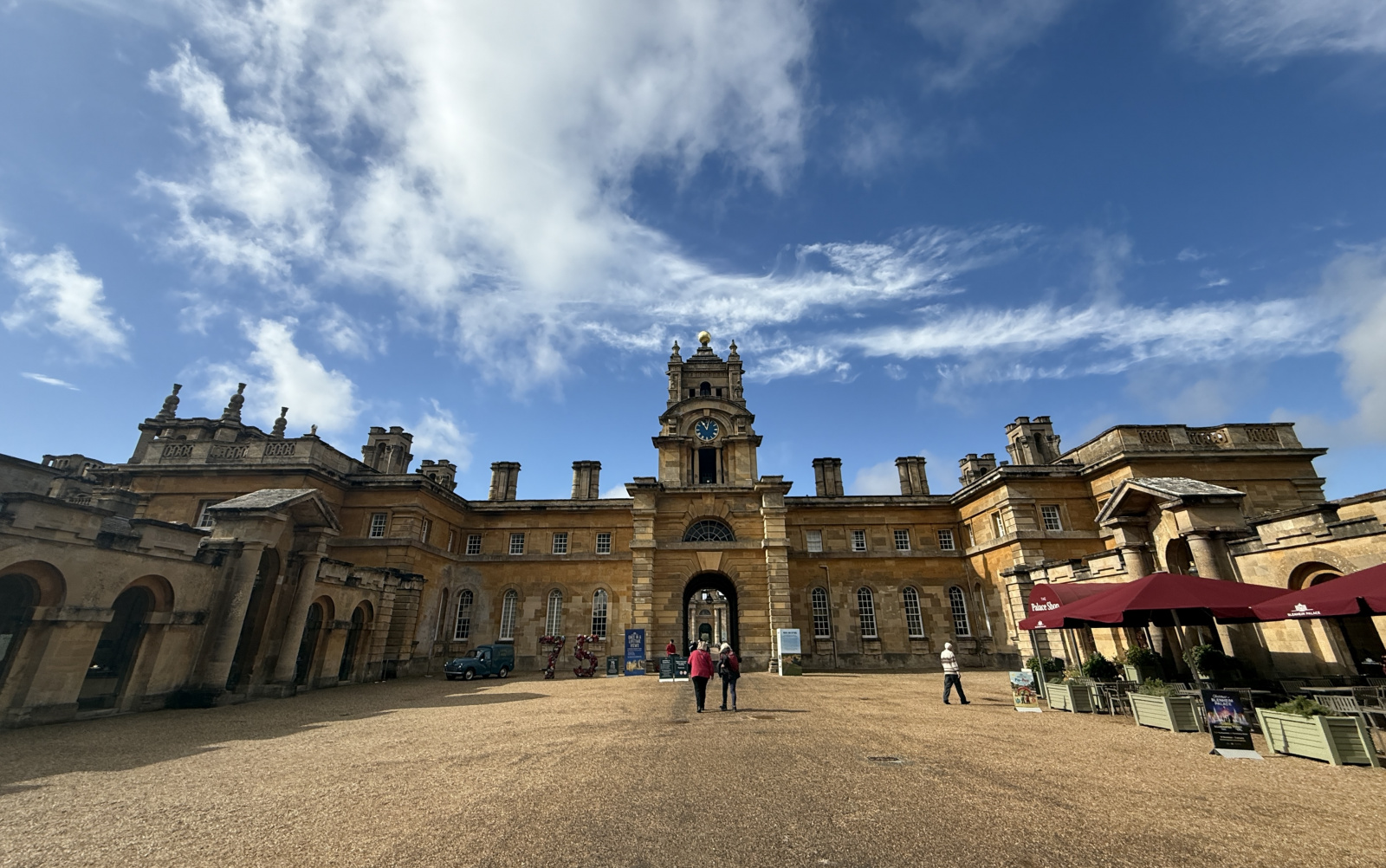
The other side of the Palace: still very worth a visit.
So now that your expectations have been managed and you won’t be taken by surprise by the sight of a Palace in a toga, let’s take a brief initial look at the competition itself.
As always, the FEI European Championships is held at CCI4*-L level. The test used this week will be CCI4*-D, and we’ll see the cross-country phase play out over a 5800m track utilising 40 jumping efforts. For folks who tune in to Blenheim each year, it’ll feel very familiar: the route used is very nearly exactly the same one as last year, with one or two very minor deviations.
This year, usual course designer David Evans has stepped out of the spotlight to welcome Captain Mark Phillips into the role – his final hurrah before retiring from course design. David will still play a major part in the event, though: he’s the designer for the eight- and nine-year-old CCI4*-S, which will run alongside the competition (though no Euros riders will be allowed to take part), and is course builder, too. Mark, who was longtime course designer at Burghley and, notably, designed the course for the 2018 World Championships, has never produced a Blenheim course.
Though we’ll be bringing you a more in-depth look at what he’s set for us later on this week, we did get an early opportunity to cruise around the course with the man himself last week.
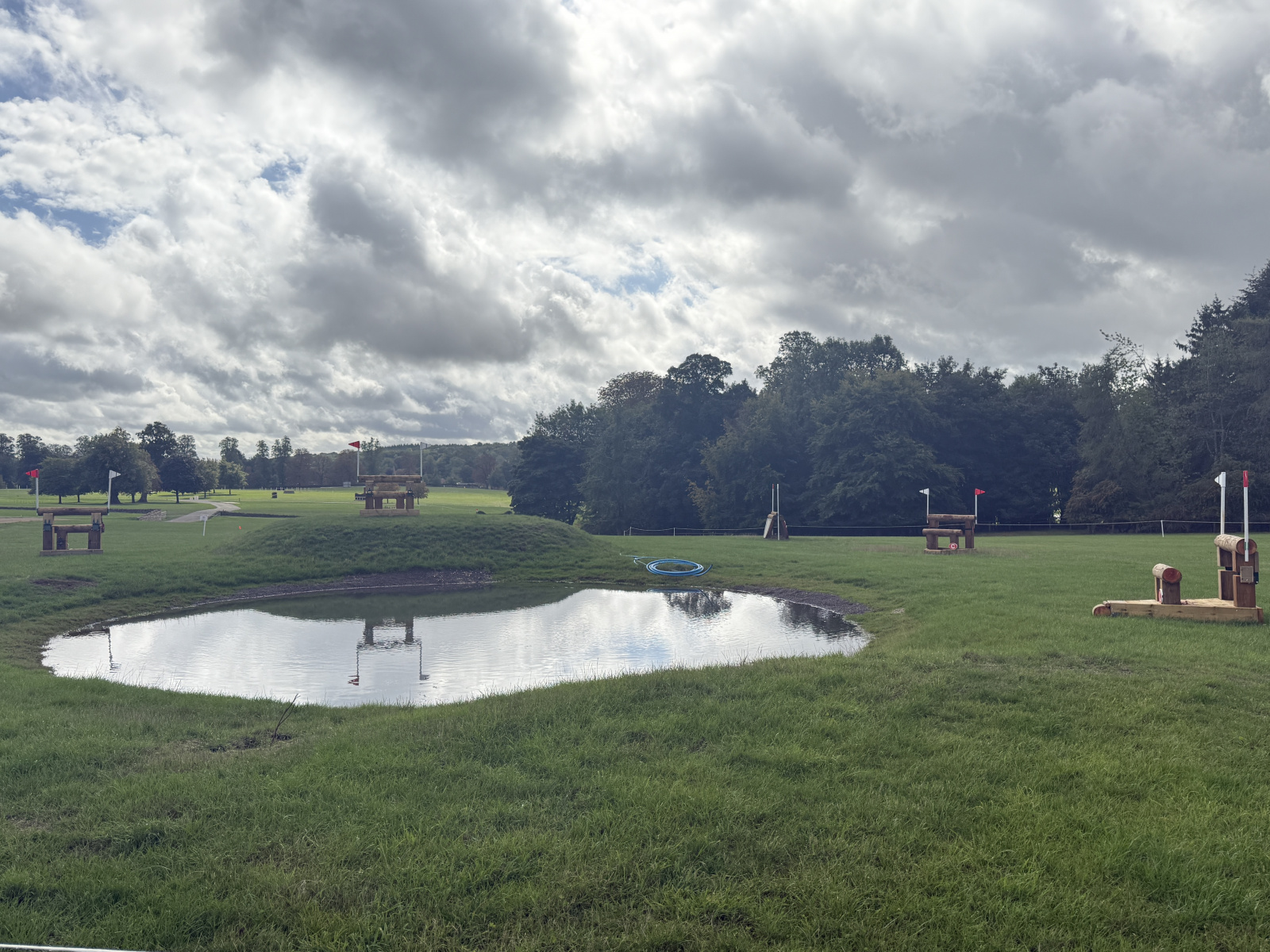
The first combination: the Dew Pond at 6ABC.
The course has an unusually long lead-in to the first combination: there are simple, single fences from 1 to 5, and the first combination doesn’t come up until around the two minute marker at 6ABC. That first combination is also the first water splash-through, though it really is just a splash: the Dew Pond feature near the heart of the event site, which has been used more recently as part of the arena eventing competition, has been reclaimed for the main track, and will feature a related distance of two relatively unobtrusive skinny triple bars on either side of the little pond, incorporating a mound at the first element which makes the jump itself come up a bit more suddenly for horses who might be prone to distraction.
While the jumps themselves don’t look particularly in-your-face, Mark explains that their complexity is actually in their visibility to horses.
“Horses have 340-degree vision,” he says. “They don’t see ten degrees directly in front, nor ten degrees directly behind them. So they don’t actually see the bit of the fence they’ve got to jump, and instead, they draw information from the side. Here, they’ll come over the hill and have a lot of information coming from either side that doesn’t have much of anything to do with the little skinny they’ve got to jump.”
If the first couple of minutes of the course feel quite light on efforts – which makes it a good chance to get up on the clock, for those very competitive pairs – the next few are considerably busier. From the arena question, the Joules Pavilion to Joules Palace View at 8 and 9 to the Agria Angles at 10ABC, over the South Lawn from the Subaru Sensation at 11ABC to the Palace Treasure Chest and Jewellery Box at 12 and 13, there’s plenty to do – and plenty to slow competitors down.
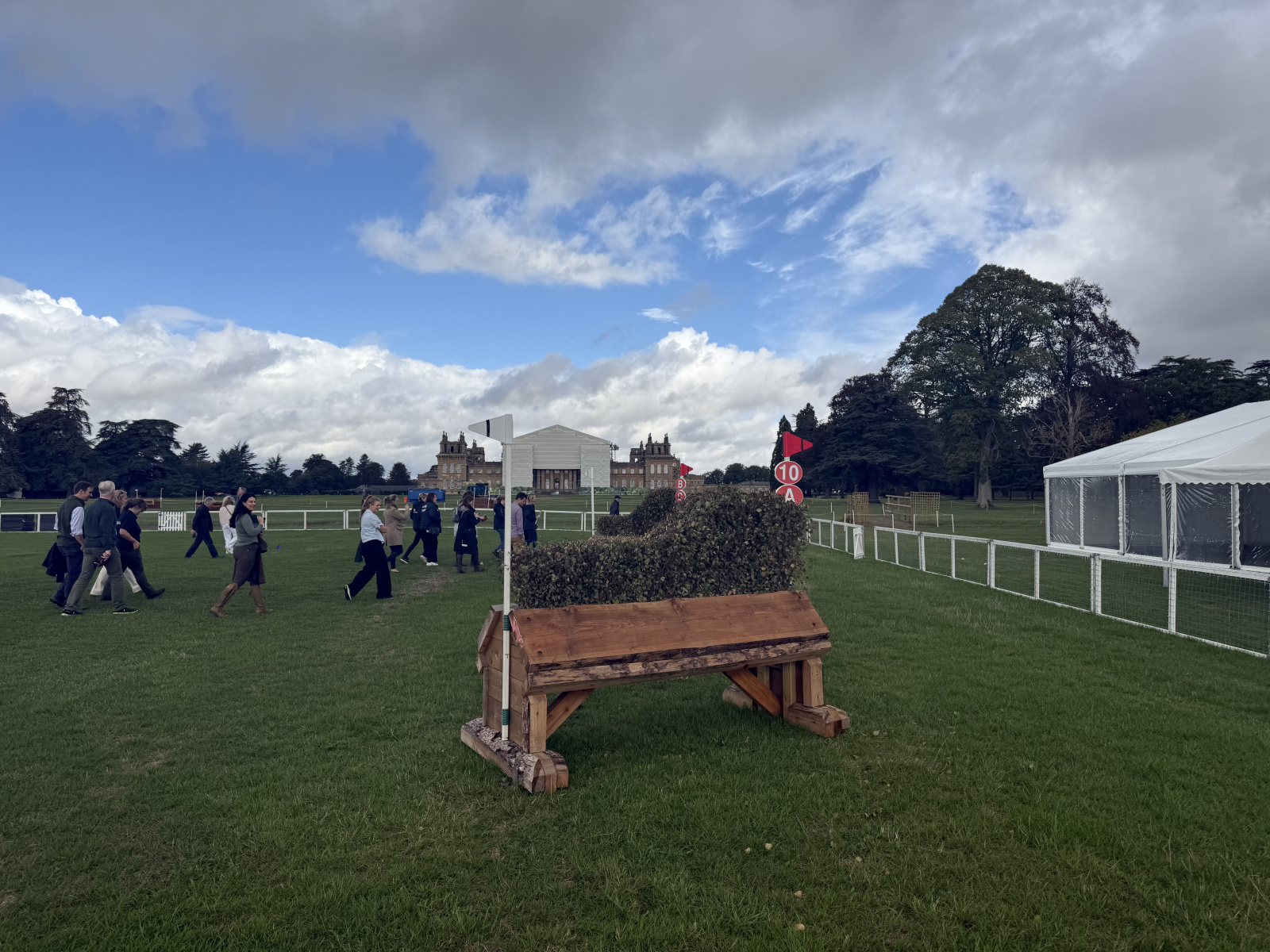
The one-stride Agria Angles fence in the arena at 10ABC.
“At three minutes they come into the arena, where there’s a table to a table, and then an angled brush to an angled brush [on one stride],” says Mark. “If there’s a runout there, it’ll be into the middle of the arena – so if there’s something happening in the tent alongside it, a bottle of champagne being opened or something, the horses will have an open door to come out to the left rather than going over the fence. The crowd will certainly be something that riders will have to think about.”
Then, they’ll head to the South Lawn complex from 11ABC to 12 and 13, which Mark has tipped as “probably the most difficult combination on the course”. They’ll tackle this with horses still fresh and, perhaps, not yet at their most rideable after a relatively easy run so far – and this will likely be the busiest spectator section of the course, too, so there’s plenty to distract them. But this question also feels familiar: it sees the return of the treasure chest complex that usually sits on this South Lawn spot. 11ABC encompasses a wide table fence to two left-handed corners, with plenty of options available for less experienced horses or riders, or those who aren’t yet stuck into the task.
“Anyone who cheats and squares up the first corner is in trouble,” says Mark, “because they won’t find the line to the second corner.”
Then, the chests on a bending left-handed line at 12 and 13 come up fast, and though they’re certainly related to the fences at 11ABC, Mark has opted to number them separately to give people a chance to find a route through if they get discombobulated. Those slower, kinder options are crucial for a European Championships, which sees nations come in with a variety of goals – winning medals on one end of the spectrum; getting around and gaining experience on the other. But where there are options, there is also plenty of time to lose, and Mark reckons for all competitors, time will be of the essence this weekend.
“Up until the four minute marker they’re going to be stuck at around 400 or 450 meters per minute, down from 570, for a good 45 seconds, which is why the time will be so difficult,” says Mark. “Of course, if there are issues, there are plenty of longer options – but if you take all those longer options, you’ll probably be late for tea.”
After the South Lawn complex, there’s an open gallop down to a single fence at 14, and then the Raging Bull Roller Coaster at 15AB, which is another familiar combination: two skinny brush-topped fences, an option of four or five strides apart, atop a pair of knolls, which challenges horses and riders to stick to their line while the terrain changes underneath them. Then, they’ll get airborne again over a big single oxer before heading to the first of Blenheim’s long water crossings.
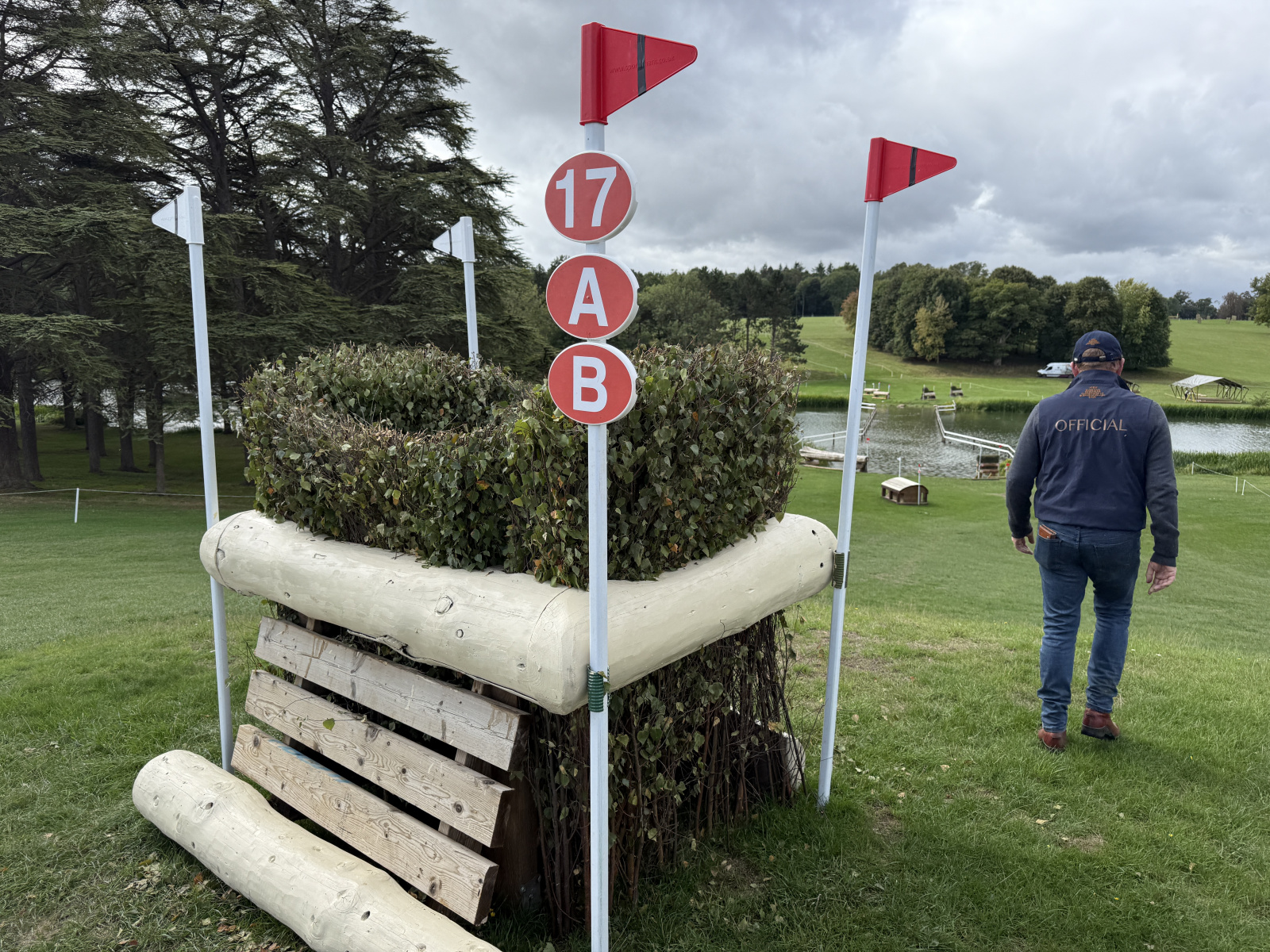
The into-space fence at 17AB.
Before they can get their feet wet, there’s a couple of fences to jump: the BE Support Trust Healing Garden at 17ABC features an into-space brush fence with a downhill landing, marked as 17AB, down to a very skinny, imposing brush fence into the water, which has some creative numbering to stop people from mixing long and short route options. The groundline is 17C, while the fence itself is 18AB, the Subaru Splash, after which they’ll gallop across the lake and then meet an option of single angled hedges at 19, the Agria Water Crossing.
“When you walk up to 17AB, the optics make it look as though you’re jumping into the lake,” says Mark. “But if they’re brave enough to accept the optic, they do actually have flat ground to land on on the other side [before they head down to 17C/18AB]. If not, the long way is super long.”
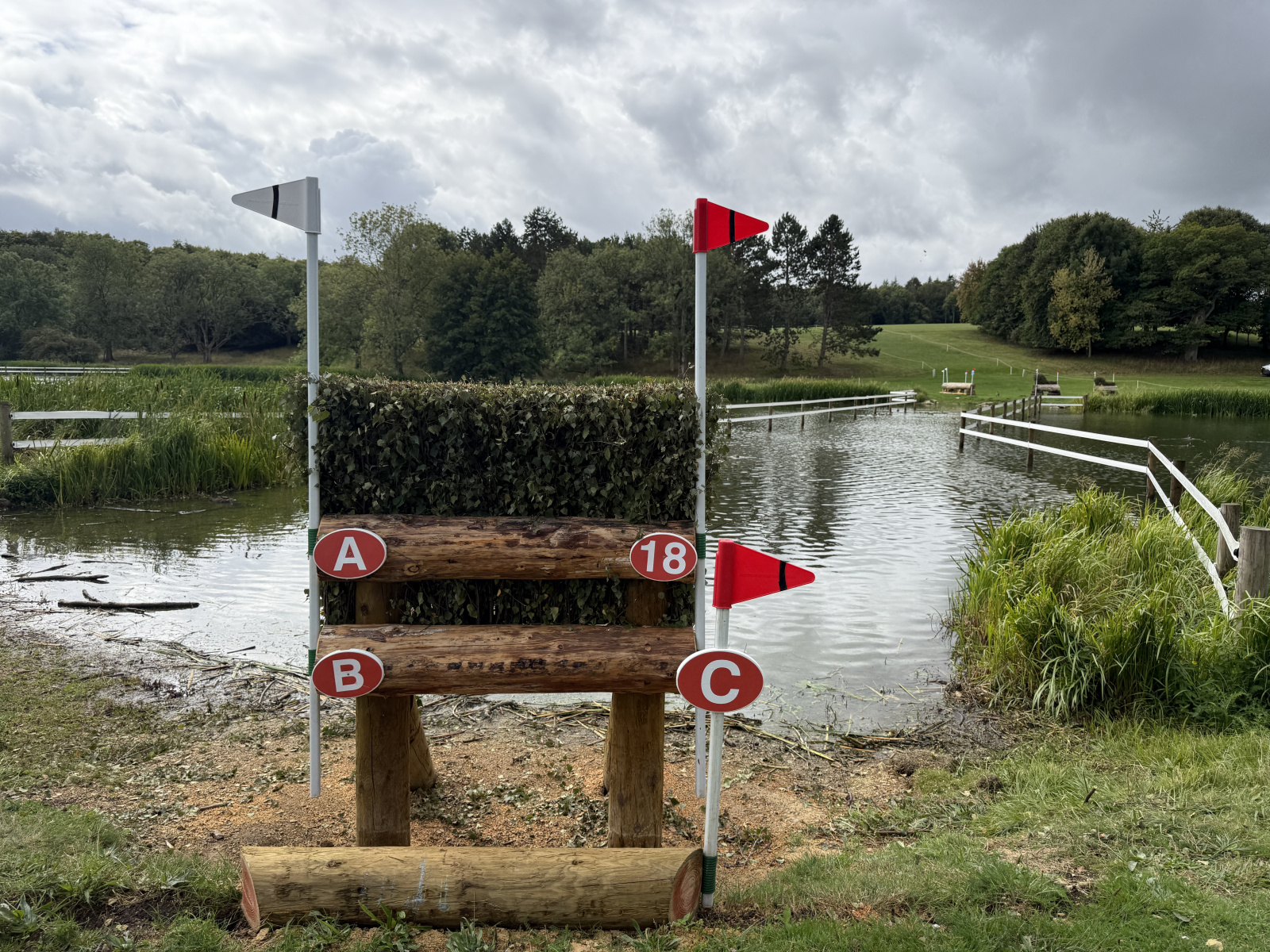
The most visually impressive fence on course is the skinny brush into the water at 17C/18AB.
On the other side of the lake crossing, which spectators can view from the Bladon Bridge, they’ll move uphill over the steepest bit of terrain to the next water question, the GFS Saddles Water at 20ABC.
“There’s quite a big log in [20AB] with a 1.80 drop in, and then a forward four strides to a brush corner [20C] in the water,” says Mark, who stresses that the quality of the jump in defines everything that comes next. “If you land normally, the four will be right there. I think you might see some try to cheat a bit and put in a bending five, but that’s going to take longer.”
The next combination, at 22AB, is the FEI Mounds, an open oxer to a right-handed corner on a gentle bending line with some variable terrain in between. There is to be a line of Christmas trees, which Mark expects to open a chute for a run-out – though as a mere mortal walking the line, it reads as though the trees will actually guide horses and riders onto the correct line, so this spot will be one we’ll watch with interest early on Saturday to see how horses are reading it. Of course, as we saw at Burghley’s Maltings question, which had a similar setup of flower pots on the approach, sometimes having the perfect line handed to you makes things harder: you can’t then add in a bend to adjust the stride pattern if you’re not quite on the money, nor can you create a more direct approach to the corner.
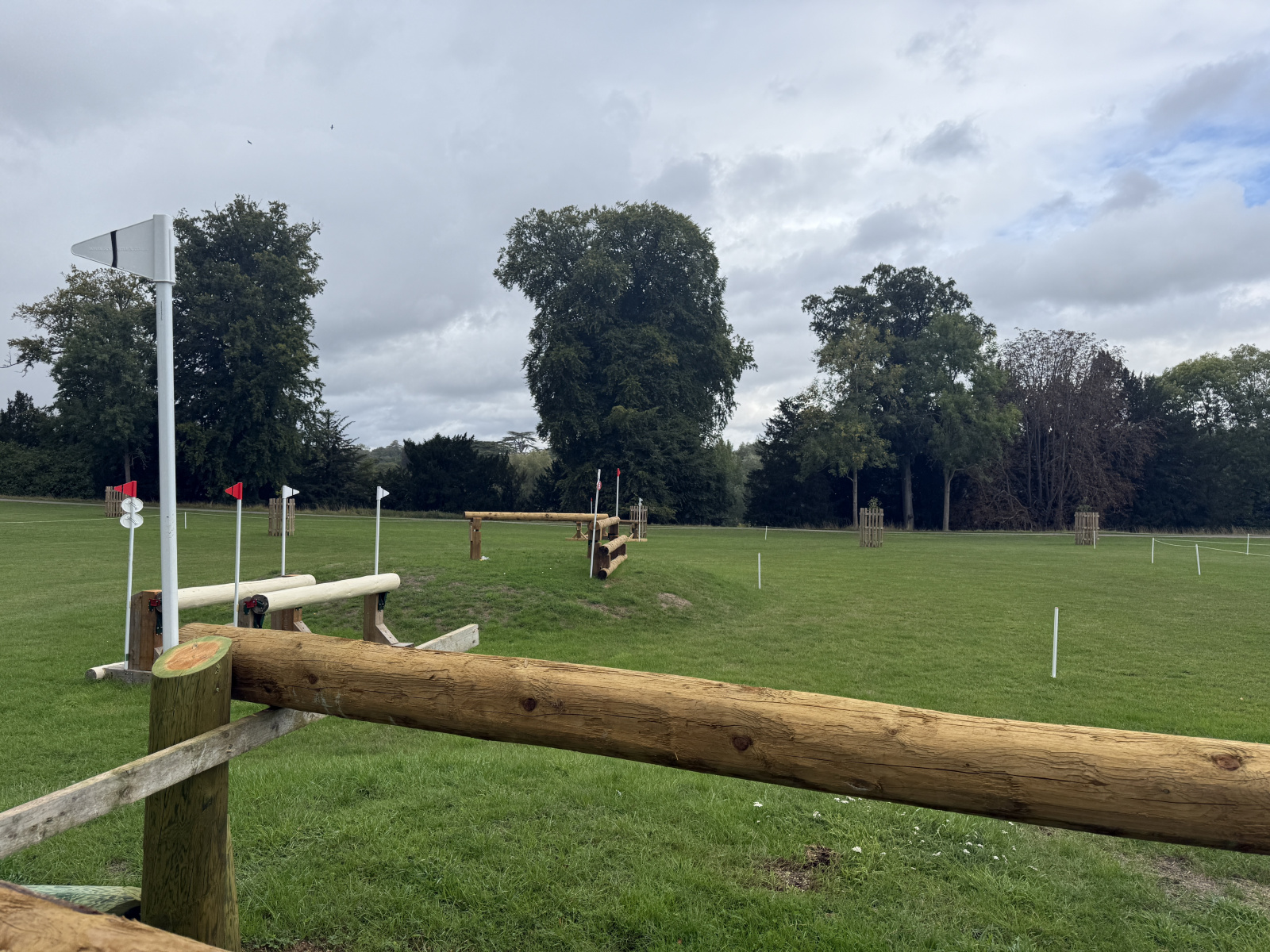
The view to the corner at 22B from 22A. The two white posts on the right mark the line of trees that’ll be placed for this week.
“When they land over the oxer, they’re going to see the wide open door straight ahead, but there’s a four or a five [stride line] there, and you have to say, ‘No, you’re not going through the door. You’ve got to go over the corner’. Not easy! I’m a bit pissed off with Derek [diGrazia, Burghley course designer] because he had the same question at the Maltings. And everybody’s going to say that I copied Derek,” laughs Mark.
There’s a tiny loop of new ground next on the course as they approach 23AB, the LeMieux Wedge, which is a simple skinny chevron fence — but one that comes up on a 90-degree left-handed turn, with a little gully of terrain in front of it.
“It’s a footwork exercise: you’ve got to go forwards so they can pat the ground and jump,” Mark explains. “They’re coming up on seven minutes twenty, probably, and they’ll be a little bit slower with their feet, but they’ll have to be quick here. They’ll jump it or they’ll skip around it, but nobody’s won until they’ve jumped this.”
There’s the return of the coffin in the woods at 25ABC, the CrossCountry App Wooded Hollow, though with a crucial change: it’s a half coffin, not a full one as we ordinarily see here, so there’s just the rail and the ditch to pop over – but equally, we often see the first rail’s MIM clip knocked in normal years if riders zoom into the approach. After that, Mark says, from fence 26 through to the finish at 31, riders have an easier job to do and will be cross with themselves if they manage to make a mistake.
Over the span of the course, he tells us that his mission has been to make riders think while creating lines and routes that are readable for their mounts.
“My mantra,” he explains, “is always to be as unkind as you can to the rider while being as kind as you can to the horse.”
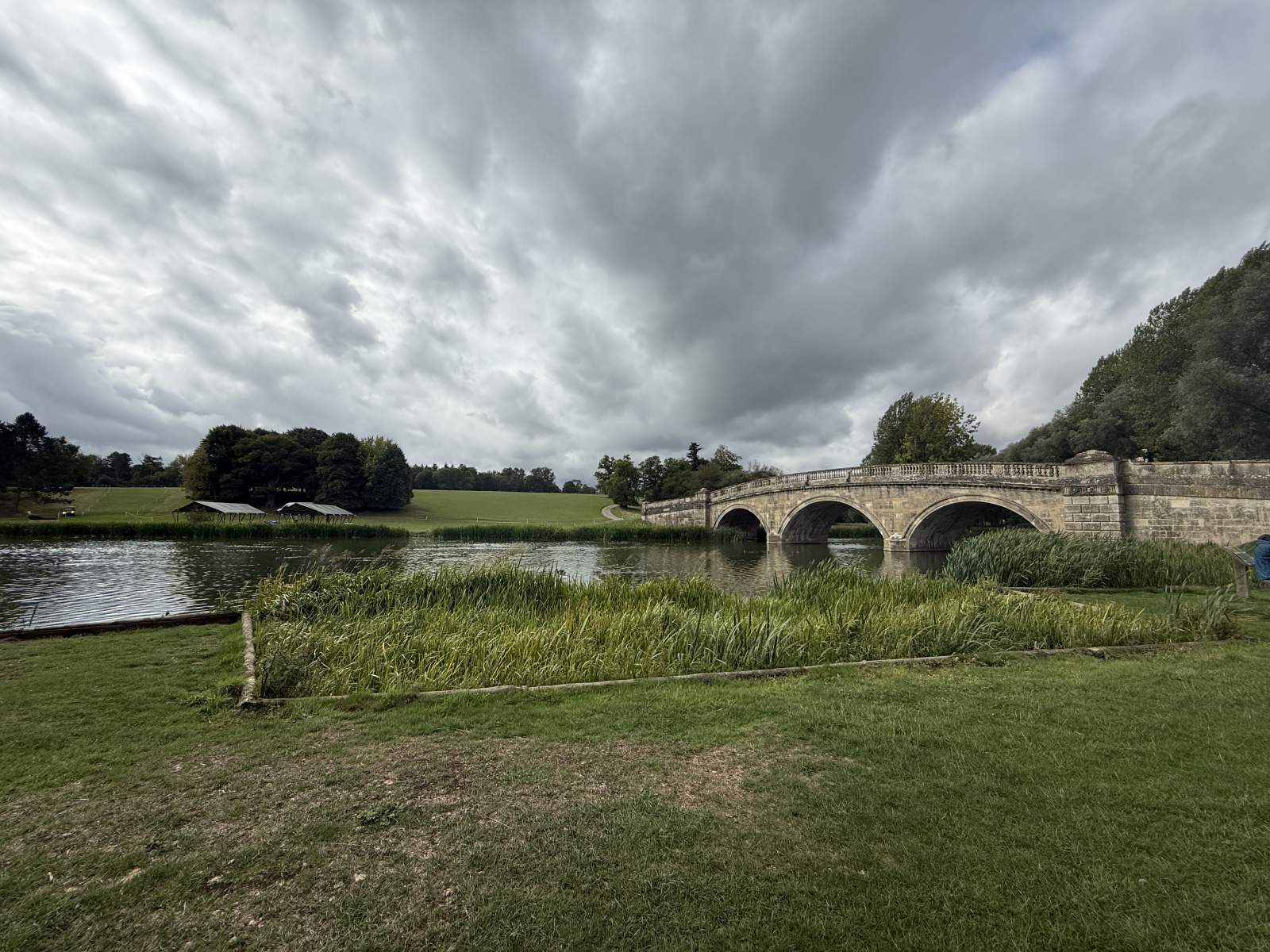
The Bladon Bridge, where spectators can access the back half of the course and watch the water crossings from on high.
There are only so many impressions you can get from a quick drive around a course that isn’t fully dressed yet, but at first glance, this week’s Championships track does, admittedly, look slightly smaller and less intensive than some we’ve seen in previous Championships – though Blenheim’s reasonably variable terrain will certainly play its own part this week. There’s also some clever, tricky numbering in many of the route options, so riders will need to ensure they keep their wits about them and walk all alternatives a number of times, because we could well see someone eliminate themselves for jumping a letter twice or missing one entirely.
And if it is an easier track once we’ve all walked it, walked it again, discussed it eighteen times and agonised late into the night over it? Well, complacency has always brought its own unique set of difficulties with it, hasn’t it?
In any case, this isn’t Blenheim’s first rodeo where FEI European Championships are concerned – in 2005 they also hosted them, and in similarly wet conditions. Zara Tindall – nee Phillips – was crowned the European Champion on that occasion, with Great Britain taking team gold for a sixth consecutive time. This year, the Brits come into Blenheim having won on the last two occasions, and though reigning individual champion Ros Canter is sitting this week out, the home side remains the firm favourite to take the win again. On Britain’s last hosting stint in 2015 – this time at Scotland’s Blair Castle, where it was also really, really wet – the Brits won silver, losing out on gold to Germany, so they’ll be keen to redress the balance this week.
A fun fact for you: did you know that the last time a team other than Germany or Britain won European Gold was way back in 1993, when Sweden took it? The two nations have been so dominant that just four other countries have ever managed it in 36 runnings: Sweden, in ‘93 and ’83; the former West Germany (the more fun of the Germanies, inarguably) in ’59 and ’73; Ireland, in ’79; and the former Soviet Union in ’62, ’65, and ’75.
Whichever team tops the podium, they’ll need to be prepared to dig deep for it: after a very dry, hot year in the UK, the heavens have resolutely opened over the last couple of weeks, and more rain is forecast throughout the competition. That’s been something of a godsend for the parched ground, especially as the multi-use nature of the Palace estate means that the event team can’t get on-site to do groundwork until just weeks before the competition, but it could also make for some tricky conditions, deep and tacky going, and slippery spots that’ll make catching the time even harder. A further complication? All three phases are on grass at Blenheim, so dressage and showjumping could both see an additional element of difficulty thrown in. Our advice? Wear waterproof layers, pack an extra pair of socks, fill a flask with something warming, and be prepared to celebrate the best of British weather in true native pony fashion: with your bum turned to the wind.
And what about here on EN? Well, as always, you can rely on us for daily long-form reporting on the competition, with insights and analysis from the biggest movers and shakers every day. Plus, we’re excited to be double-handed in the mixed zone this week, with Catherine Austen once again joining us to bring you the best of the stories beyond the top ten – and this week, we’re jam-packed with them. We’ll also have closer looks at Captain Mark Phillips’ course, live updates from stable star Cheg Darlington, and a team form guide, which will land tomorrow and give you a closer look at each nation vying for glory this week.
Following along from home and want to ensure you see every ride? All livestream coverage this week will come to you via ClipMyHorse.TV, which hosts the FEI TV platform. CMH will feature both days of dressage and both jumping phases, and the first horse inspection on Wednesday as well as the Opening Ceremony will be carried live on the FEI’s YouTube channel.
EN is proud to welcome Horsepal onboard as the sponsor of our European Championships coverage! Horsepal is a newly-launched heart rate monitor brought to you by Tom MacGuinness, founder of Horseware and an FEI eventer and endurance rider, who’s brought his decades of knowledge to practice in the design of Horsepal. You can now purchase Horsepal directly to the UK and Europe — learn more here.
The Agria FEI European Eventing Championships at Blenheim: Website | Tickets | Live Stream | FEI YouTube Streams | Entries | EN’s Coverage
| Support Our Sponsor: Horsepal

